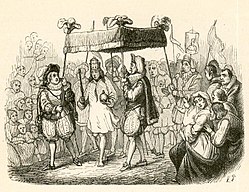| "The Emperor's New Clothes" | |||
|---|---|---|---|
| Short story by Hans Christian Andersen | |||
 Illustration by Vilhelm Pedersen, Andersen's first illustrator | |||
| Original title | Kejserens nye klæder | ||
| Country | Denmark | ||
| Language | Danish | ||
| Genre(s) | Literary folktale | ||
| Publication | |||
| Published in | Fairy Tales Told for Children. First Collection. Third Booklet. 1837. (Eventyr, fortalte for Børn. Første Samling. Tredie Hefte. 1837.) | ||
| Publication type | Fairy tale collection | ||
| Publisher | C.A. Reitzel | ||
| Publication date | 7 April 1837 | ||
| Chronology | |||
| |||
| Part of the Politics series |
| Republicanism |
|---|
|
|
"The Emperor's New Clothes" (Danish: Kejserens nye klæder [ˈkʰɑjsɐns ˈnyˀə ˈkʰlɛːðə]) is a literary folktale by the Danish author Hans Christian Andersen about a vain emperor whose folly gets exposed before his subjects. The tale was first published with "The Little Mermaid" in Copenhagen, Denmark, by C. A. Reitzel, on 7 April 1837, as the third and final installment of Andersen's Fairy Tales Told for Children. It has since been adapted to various media, and translated into more than 100 languages.[1]
The tale serves as a modern-day parable, illustrating the concepts of gaslighting and groupthink as well as the follies of vanity and authoritarianism,[2][3] while the story's title, the phrase "the Emperor has no clothes", and variations thereof have been adopted for use in numerous other works and as idioms.

- ^ Andersen 2005a 4
- ^ "Something widely accepted as true or professed as being praiseworthy due to an unwillingness of the general population to criticize it or be seen as going against popular opinion." http://idioms.thefreedictionary.com/the+emperor's+new+clothes
- ^ Adam Przeworski has theorized that "authoritarian equilibrium rests mainly on lies, fear and economic prosperity" in "Democracy and the Market: Political and Economic Reforms in Eastern Europe and Latin America" [1]